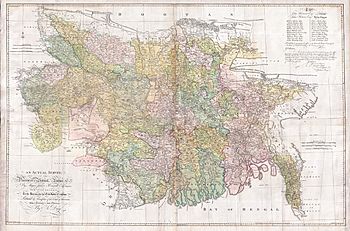Nawab of Bengal facts for kids
Quick facts for kids
Nawab Nazim of Bengal and Orissa (1717–1880)a
and Nawab Bahadur of Murshidabad (1882–1971)b Nawabs of Bengal and Murshidabad
|
|||||||||||||||||
|---|---|---|---|---|---|---|---|---|---|---|---|---|---|---|---|---|---|
| 1717–1765 | |||||||||||||||||
|
Motto: Nil Desperandum
"There is no cause for despair, never despair" |
|||||||||||||||||
 |
|||||||||||||||||
| Capital | Murshidabadc | ||||||||||||||||
| Common languages | English Arabic |
||||||||||||||||
| Government | Nobility | ||||||||||||||||
| Historical era | Mughal Empire British India |
||||||||||||||||
|
• Emergence of the Mughal Empire
|
1526 | ||||||||||||||||
|
• Established
|
1717 | ||||||||||||||||
| 23 June 1757 | |||||||||||||||||
| 22 October 1764 | |||||||||||||||||
|
• Abolition of the title of Nawab of Bengal
|
1880 | ||||||||||||||||
|
• Abdication of Mansoor Ali Khan, the last Nawab of Bengal
|
1 November 1880 | ||||||||||||||||
|
• Emergence of the Nawab of Murshidabad
|
17 February 1882 | ||||||||||||||||
|
• Article 18 of the Indian Constitution abolishes titles, except those given by the Government of India to those who have made their mark in military and academic fields
|
26 January 1950 | ||||||||||||||||
|
• Disestablished
|
1765 | ||||||||||||||||
| Population | |||||||||||||||||
|
• 1901
|
75 million | ||||||||||||||||
|
|||||||||||||||||
| Today part of | |||||||||||||||||
|
|||||||||||||||||
The Nawabs of Bengal were powerful rulers in the regions of Bengal and Odisha. From 1717 to 1772, they governed these areas. The title "Nawab" means a high-ranking ruler or governor.
The Last Independent Nawab
The last Nawab who ruled independently was Siraj ud-Daulah. He faced a big challenge from the British. In 1757, a major battle happened, called the Battle of Plassey. Sadly, Siraj ud-Daulah was betrayed by one of his own generals, Mir Jafar.
Because of this betrayal, Siraj ud-Daulah lost the battle to the British. After their victory, the British put Mir Jafar in charge as the new Nawab. This event marked the beginning of the British becoming a very strong political power in Bengal.
British Control and the End of the Nawabs
In 1765, the British introduced a system called 'dual government'. This meant the Nawabs were still technically in charge, but they actually ruled for the British. They became like puppets, doing what the British wanted.
By 1772, the British ended this dual government. They took direct control over Bengal. This meant the Nawabs no longer had any real power.
In 1793, even the Nawab's role as governor, called the Nizamat, was taken away. From then on, the Nawabs became like pensioners. They received money from the British East India Company but had no power.
The very last Nawab of Bengal was Mansur Ali Khan. He gave up his title on November 1, 1880. His eldest son, Hassan Ali Mirza, took over the family's position, but without the old ruling power.
Images for kids
-
Robert Clive meeting Mir Jafar during the Battle of Plassey in 1757.






